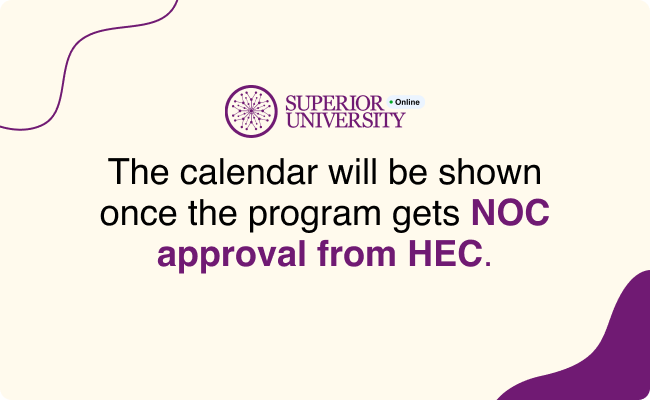BS Cyber Security
Program Educational Objectives (PEOs)
The following program educational objectives (PEOs) are expected to be demonstrated by Cyber Security graduates within 4 years of their graduation. Cyber Security professionals will:
PEO 1: Graduates will be proficient in designing, implementing, maintaining, and managing cost-effective cyber security technologies by applying attained cyber security skills.
PEO 2: Graduates will understand the ethical, legal, and social implications of their occupation and will demonstrate ethical values through responsible behavior and a positive contribution to society.
PEO 3: Graduates will be able to act as effective team players, leaders, and strong communicators in both verbal and written form.
PEO 4: Demonstrate effective communication, teamwork, and interpersonal skills to positively impact society and advance professionally.
PEO 5: Graduates will possess strong analytical and critical thinking skills necessary for identifying and solving complex cyber security challenges in various contexts.
Program Learning Outcomes (PLOs)
Here are the Program Learning Outcomes (PLOs) for the BS Cyber Security program, based on the provided details:
PLO 1: Professional Knowledge
Prepare graduates as Cyber Security professionals through educational depth and breadth, ensuring they have a comprehensive understanding of the field.
Prepare graduates as Cyber Security professionals through educational depth and breadth, ensuring they have a comprehensive understanding of the field.
PLO 2: Application of Knowledge
Apply knowledge of computing and cyber security fundamentals, mathematics, and science for the abstraction and conceptualization of computing models from defined problems and requirements.
Apply knowledge of computing and cyber security fundamentals, mathematics, and science for the abstraction and conceptualization of computing models from defined problems and requirements.
PLO 3: Problem Identification and Solving:
Identify, formulate, research literature, and solve complex computing and cyber security problems, reaching substantiated conclusions using fundamental principles of mathematics, computing, cyber security, and relevant domain disciplines.
Identify, formulate, research literature, and solve complex computing and cyber security problems, reaching substantiated conclusions using fundamental principles of mathematics, computing, cyber security, and relevant domain disciplines.
PLO 4: Solution Design and Evaluation
Design and evaluate solutions for complex computing and cyber security problems, and design and evaluate systems, components, or processes that meet specified needs with appropriate consideration for public health and safety, cultural, societal, and environmental considerations.
Design and evaluate solutions for complex computing and cyber security problems, and design and evaluate systems, components, or processes that meet specified needs with appropriate consideration for public health and safety, cultural, societal, and environmental considerations.
PLO 5: Techniques and Resources Application
Create, select, adapt, and apply appropriate techniques, resources, and modern computing and cyber security tools to complex computing activities, with an understanding of the limitations.
Create, select, adapt, and apply appropriate techniques, resources, and modern computing and cyber security tools to complex computing activities, with an understanding of the limitations.
PLO 6: Teamwork and Leadership
Function effectively as an individual and as a member or leader in diverse teams and in multi-disciplinary settings.
Function effectively as an individual and as a member or leader in diverse teams and in multi-disciplinary settings.
PLO 7: Effective Communication
Communicate effectively with the computing community and with society at large about complex computing and cyber security activities, by being able to comprehend and write effective reports, design documentation, make effective presentations, and give and understand clear instructions.
Communicate effectively with the computing community and with society at large about complex computing and cyber security activities, by being able to comprehend and write effective reports, design documentation, make effective presentations, and give and understand clear instructions.
PLO 8: Societal and Global Impact
Understand and assess societal, health, safety, legal, and cultural issues within local and global contexts, and the consequential responsibilities relevant to professional computing and cyber security practice.
Understand and assess societal, health, safety, legal, and cultural issues within local and global contexts, and the consequential responsibilities relevant to professional computing and cyber security practice.
PLO 9: Professional Ethics
Understand and commit to professional ethics, responsibilities, and norms of professional computing and cyber security practice.
Understand and commit to professional ethics, responsibilities, and norms of professional computing and cyber security practice.
PLO 10: Lifelong Learning
Recognize the need, and have the ability, to engage in independent learning for continuous development as a cyber security professional.
Recognize the need, and have the ability, to engage in independent learning for continuous development as a cyber security professional.
PEOs-PLOs Mapping
| PLOs | PEO 1 | PEO 2 | PEO 3 | PEO 4 | PEO 5 |
|---|---|---|---|---|---|
| PLO-01: Professional Knowledge | ✔ | ||||
| PLO-02: Application of Knowledge | ✔ | ||||
| PLO-03: Problem Identification and Solving | ✔ | ||||
| PLO-04: Solution Design and Evaluation | ✔ | ||||
| PLO-05: Techniques and Resources Application | ✔ | ||||
| PLO-06: Teamwork and Leadership | ✔ | ||||
| PLO-07: Effective Communication | ✔ | ||||
| PLO-08: Societal and Global Impact | |||||
| PLO-09: Professional Ethics | ✔ | ||||
| PLO-10: Lifelong Learning | ✔ | ✔ |


